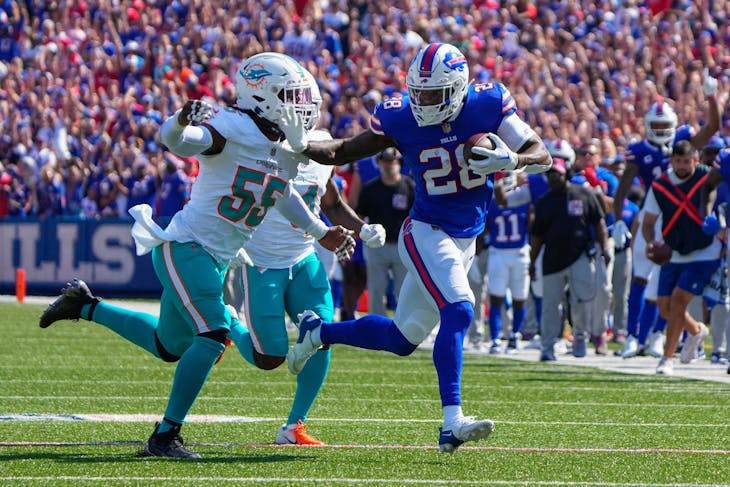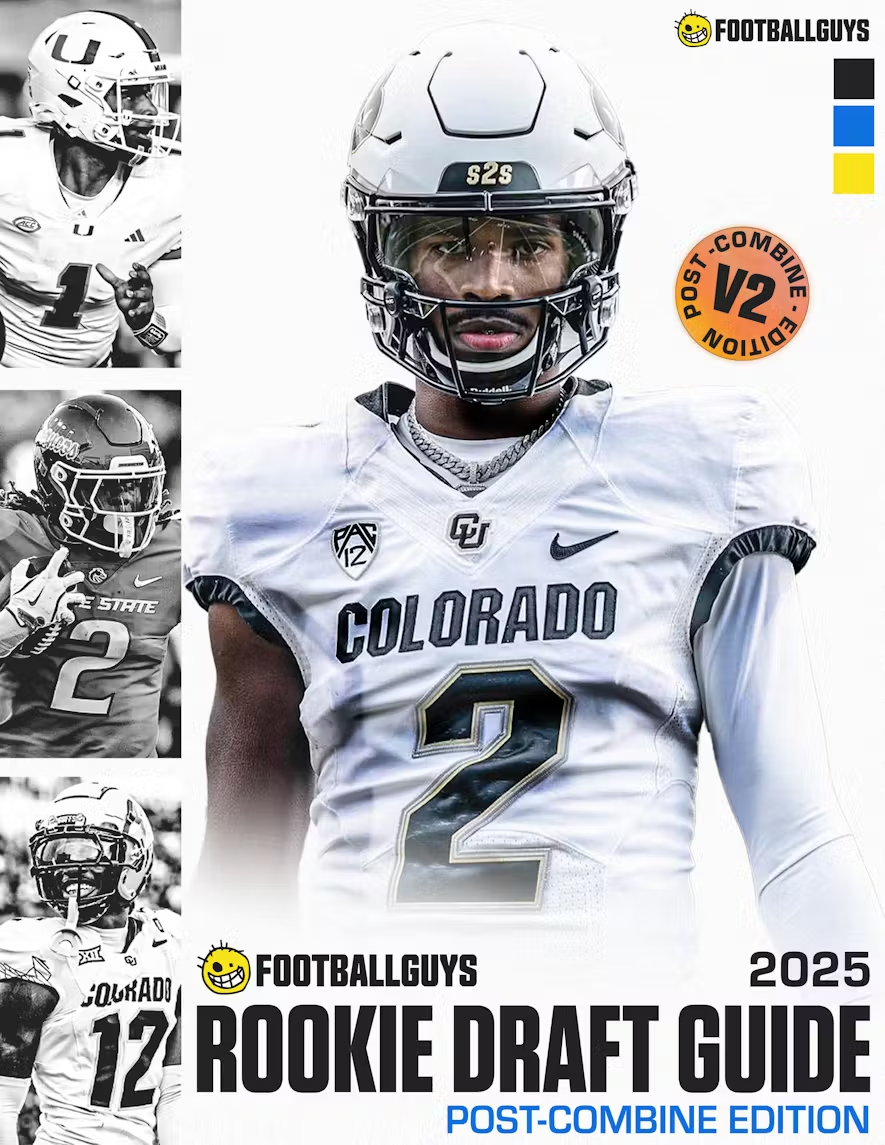
We hear the phrase upside repeatedly in fantasy football circles. However, upside alone does not describe fantasy league-changing players. A comparison to a player's cost is a key attribute. The concentration of production to a short window can even add to a player's appeal. Here is a look at the potential league-changing players at each skill position and the simple story of their arrival by the season's end with their mid-July ADP attached.
QUARTERBACKS
Jalen Hurts, QB8-14
Why: In four starts last season, amidst his passing struggles, he posted 272 yards on the ground, a pace that would be second in NFL history for quarterbacks. While passing limitations or a lack of growth can hinder Hurts' chances for starting longevity in the NFL, his audition in 2021 should be a pronounced one with only Joe Flacco and Nick Mullens on the depth chart for pressure. Rushing is the absolute fast track for elite fantasy seasons at quarterback. Combine a near-record-setting rushing season for Hurts with a decent showing for Devonta Smith and Jalen Reagor (both Round 1 selections) atop the wide receiver depth chart, and Hurts has a path to an elite finish. The biggest preseason wrinkle is if Deshaun Watson, a heating up to-be-traded player, lands in Philadelphia.
Deshaun Watson, QB16-22
Why: The simple hurdle is Watson being active this season. Houston is likely to struggle, which will promote Watson as the playmaker to carry the team. Watson has three straight top-seven aPPG finishes and, even with Will Fuller notably gone from his weaponry in 2020, Watson can crush his ADP by simply being active and starting in Houston (or somewhere else).
Trey Lance, QB20-30
Why: See Jalen Hurts' write-up for a sense of Lance's rushing potential. Paired with Kyle Shanahan and a strong collection of weapons, Lance can be aided with his passing progression with defined reads and schemed-open receivers. Lance is in a small subset of quarterback prospects with >6.0 yards-per-carry in high school and college. The other qualifiers? Kyler Murray, Lamar Jackson, Marcus Mariota, and Johnny Manziel. Monitor Malik Willis (2022 eligible) as the next potential qualifier. The biggest question with Lance is when he starts for the 49ers.
RUNNING BACKS
Clyde Edwards-Helaire, RB12-20, Darrel Williams, RB55+
Why: The lead, clarified starting role for the Chiefs has elite upside. Jerick McKinnon was added this offseason but has yet to show he can hold up under any meaningful volume. Edwards-Helaire is on the success track post-Year 1, with Round 1 pedigree, and enters Year 2 on an elite offense. This is a no-brainer profile for an elite RB1 outcome, yet Edwards-Helaire can be drafted as a team's RB2. Williams has a three-down profile as a younger veteran and is a league-winner in waiting. Williams is priced as one of the least expensive injury-away backs in fantasy.
Mike Davis, RB20-30
Why: Davis was a league-changing player in 2020, with Christian McCaffrey missing most of the season and Davis picking up the Carolina slack. Davis is the unchallenged starter for Atlanta outside of a late add (LeVeon Bell? Todd Gurley?) before the season starts. As it stands, Davis offers a dual-threat skillset on a team with a questionable defense and looking for playmakers on offense with Julio Jones gone to Tennessee. Davis has foundation back upside for the price of a fantasy teams' RB2/3.
Raheem Mostert (RB25-35), Trey Sermon (RB30-40)
Why: The 49ers backfield provides enough work for two running backs to be fantasy viable. Jeff Wilson is already out until midseason at the earliest and potentially the entire season. Mostert and Sermon are both quality values. The upside comes from a clarified RB1 via injury or running with the job as the hot hand. Mid-RB1 or higher production is the likely outcome.
A.J. Dillon, RB35-45
Why: Dillon has a foundation back profile, and only an Aaron Jones absence stands in Dillon's way from being a fantasy game-changer. Assuming Aaron Rodgers is Green Bay's starter, a high-end RB1 output is within reach for Dillon.
Tony Pollard, RB40-50
Why: In flashes, Pollard has shown his potential. Insert a full workload on one of the NFL's most dynamic offenses, and Pollard can hit high-end RB1 status, just like Ezekiel Elliott, if Elliott misses time.
Latavius Murray, RB40-50
Why: Murray has already shown he can be THE RB1 in fantasy over a stretch with no Alvin Kamara in the lineup. Nothing has changed on the depth chart, and Murray's elite ceiling is still in play.
Jeremy McNichols, RB80+
Why: This can be a proxy for 'insert Tennessee RB2' here. McNichols was the clear primary backup in 2020. Will Darrynton Evans win the job? Brian Hill was added as well. Consider McNichols the incumbent favorite outside of preseason clarity heading into Week 1.
WIDE RECEIVERS
Amari Cooper, WR10-15, CeeDee Lamb, WR10-15
Why: Cooper was THE WR1 during the stretch with a healthy Dak Prescott last season. Lamb will be the most likely benefactor if Cooper is out. Either one has a simple path to a strong WR1 outcome from a non-elite draft cost.
Diontae Johnson, WR20-30, Chase Claypool, WR25-35
Why: Johnson had a strong target share where drops weighed down his final fantasy tally to mid-WR2 status. Claypool is on the firm success track post-Year 1 and has a rare physical profile to (potentially) be an NFL alpha receiver. Profiles like Claypool after his rookie season become fantasy WR1 level frequently. The main limitation in Pittsburgh is having three quality receivers sharing the depth chart and targets. If one misses time, the others stand to benefit strongly.
Antonio Brown, WR40-50
Why: Brown was neck-and-neck with Mike Evans and Chris Godwin in targets once Brown returned from his suspension in 2020. What if Brown returns to his prime form, which produced six straight top-six aPPG finishes, including three as the No.1 overall fantasy wide receiver? Brown, not Evans or Godwin, is the closest receiver to what Brady had in Wes Welker and Julian Edelman as an option role and slot maven. If Brown is the WR1 for Tampa Bay in targets, he will crush his ADP.
Corey Davis, WR45-455
Why: What if Zach Wilson changes the Jets franchise in Year 1? While he was a late riser onto the NFL Draft radar, Wilson was lauded for his arm talent and ended up the odds-on favorite and ultimate 1.02 selection. If Wilson is a tide riser for the offense and Davis is the target leader on the team as expected, Davis has WR1 upside. A former top-five pick himself, Davis has alpha traits and received a hearty free-agent contract in an offseason where few significant deals were handed out.
TIGHT ENDS
T.J. Hockenson, TE5-8
Why: The Lions have significant questions at wide receiver. On a team likely playing from behind, there are targets to be had in the passing game. If Jared Goff is sneaky decent (contrary to popular opinion), Hockenson has top-1/2/3 targets and upside in a realistic outcome.
Adam Trautman, TE18-25
Why: Beyond Michael Thomas and Alvin Kamara, the Saints offense has been looking for a consistent target for multiple seasons. Thomas is out to start the season for a minimum of six weeks with his PUP list designation. Jameis Winston peppered tight ends when in Tampa Bay, and Jared Cook's departure paves the way for Trautman as a logical choice.
Blake Jarwin, TE20-30, Dalton Schultz, TE25-35
Why: Even with Dak Prescott missing most of the season, Schultz was a mid-TE2 as Jarwin's fill-in in 2020. If Jarwin or Schultz is the clear-cut starter over the other and Prescott puts in a full, healthy season, there is a TE1 outcome to be had with TE20+ prices for either option.

